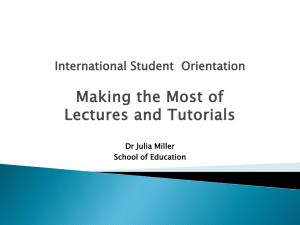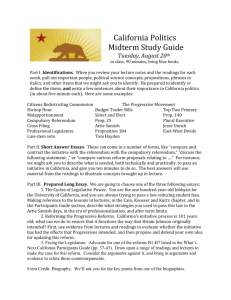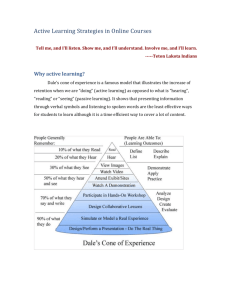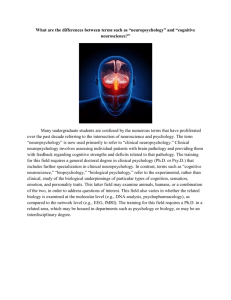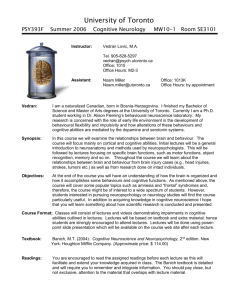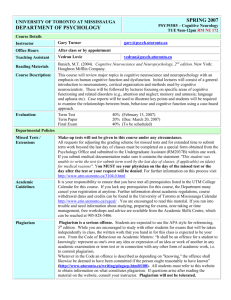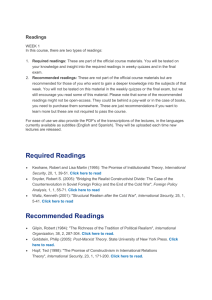Syllabus - University of Toronto
advertisement
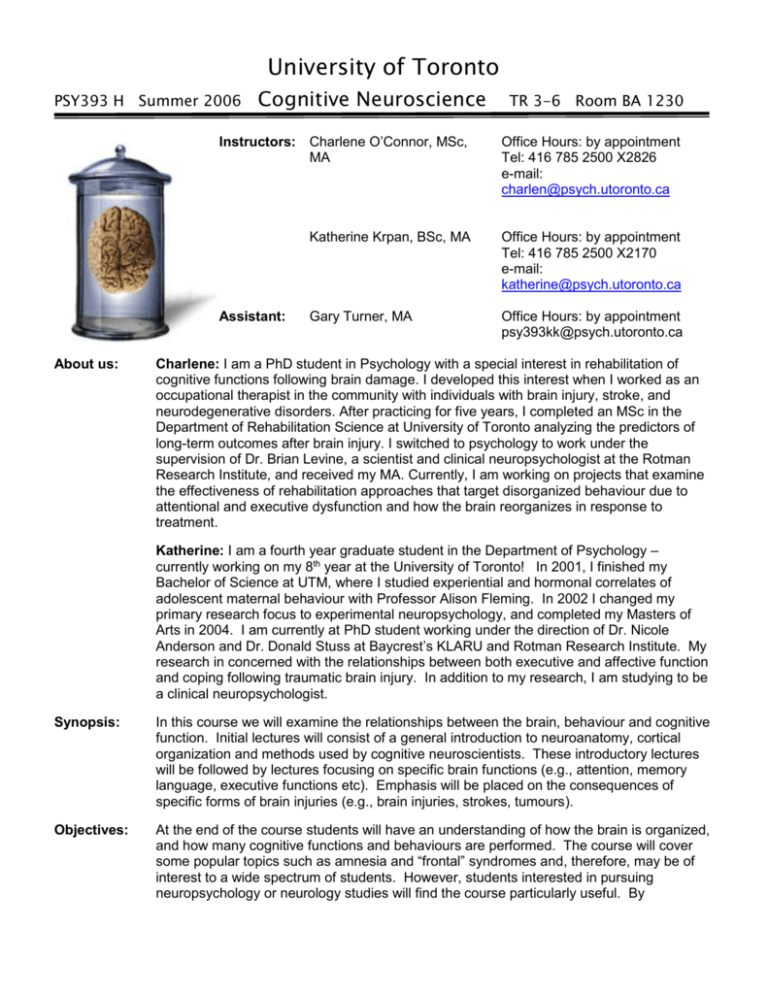
University of Toronto PSY393 H Summer 2006 Cognitive Neuroscience Instructors: Charlene O’Connor, MSc, MA Office Hours: by appointment Tel: 416 785 2500 X2826 e-mail: charlen@psych.utoronto.ca Katherine Krpan, BSc, MA Office Hours: by appointment Tel: 416 785 2500 X2170 e-mail: katherine@psych.utoronto.ca Gary Turner, MA Office Hours: by appointment psy393kk@psych.utoronto.ca Assistant: About us: TR 3-6 Room BA 1230 Charlene: I am a PhD student in Psychology with a special interest in rehabilitation of cognitive functions following brain damage. I developed this interest when I worked as an occupational therapist in the community with individuals with brain injury, stroke, and neurodegenerative disorders. After practicing for five years, I completed an MSc in the Department of Rehabilitation Science at University of Toronto analyzing the predictors of long-term outcomes after brain injury. I switched to psychology to work under the supervision of Dr. Brian Levine, a scientist and clinical neuropsychologist at the Rotman Research Institute, and received my MA. Currently, I am working on projects that examine the effectiveness of rehabilitation approaches that target disorganized behaviour due to attentional and executive dysfunction and how the brain reorganizes in response to treatment. Katherine: I am a fourth year graduate student in the Department of Psychology – currently working on my 8th year at the University of Toronto! In 2001, I finished my Bachelor of Science at UTM, where I studied experiential and hormonal correlates of adolescent maternal behaviour with Professor Alison Fleming. In 2002 I changed my primary research focus to experimental neuropsychology, and completed my Masters of Arts in 2004. I am currently at PhD student working under the direction of Dr. Nicole Anderson and Dr. Donald Stuss at Baycrest’s KLARU and Rotman Research Institute. My research in concerned with the relationships between both executive and affective function and coping following traumatic brain injury. In addition to my research, I am studying to be a clinical neuropsychologist. Synopsis: In this course we will examine the relationships between the brain, behaviour and cognitive function. Initial lectures will consist of a general introduction to neuroanatomy, cortical organization and methods used by cognitive neuroscientists. These introductory lectures will be followed by lectures focusing on specific brain functions (e.g., attention, memory language, executive functions etc). Emphasis will be placed on the consequences of specific forms of brain injuries (e.g., brain injuries, strokes, tumours). Objectives: At the end of the course students will have an understanding of how the brain is organized, and how many cognitive functions and behaviours are performed. The course will cover some popular topics such as amnesia and “frontal” syndromes and, therefore, may be of interest to a wide spectrum of students. However, students interested in pursuing neuropsychology or neurology studies will find the course particularly useful. By University of Toronto PSY393 H Summer 2006 Cognitive Neuroscience TR 3-6 Room BA 1230 completing this course you will fulfill a third year “Physiological Psychology” requirement. This course can be used as one of the prerequisites for fourth year physiology seminars. Course Format: Classes will consist of case studies, lectures and videos demonstrating impairments in cognitive abilities outlined in lectures. Lectures will be based on the textbook, with supplements from additional sources. Students are strongly encouraged to attend lectures to gain information that is not presented in the textbook. Lectures will be done using power-point slide presentation, which will be available on the course web site after each lecture. Students are strongly encouraged to take detailed notes during lecture, and supplement their notes with the PowerPoint slides at a later time. Textbooks: Banich, M.T. (2004). Cognitive Neuroscience and Neuropsychology, 2nd edition. New York: Houghton Mifflin Company. (Approximate price: $ 107.00) Readings: You are encouraged to read the assigned readings before each lecture as this will facilitate and extend your knowledge acquired in class. The Banich textbook is detailed and will require you to remember and integrate information. You should pay close, but not exclusive, attention to the material that overlaps with lecture material. In addition, a collection of supplementary readings have been specified and are available on the website for download. These readings, although not required, provide more in-depth coverage of some of the key concepts introduced in the lectures. Therefore, you will not be responsible for the details of these readings beyond the level presented in the lectures. However, these readings should be used to consolidate and clarify your understanding. Web Page: http://web.psych.utoronto.ca/~psy393kk/ Grading: Term Test Term Paper Final Exam Tests: Term tests will be based on the material from the textbook, lectures and videos. The tests will consist of multiple-choice questions (~50%; based on textbook and other readings), matching questions (based on readings and lectures) shorter and longer questions, as well as a diagram requiring you to label brain parts (based on lectures, videos and textbooks). The shorter and longer questions will require students to integrate knowledge analytically (i.e., you will be required to show us that you have not only memorized course material, but that you understand it). Please see sample question examples on the web. 40% 20% 40% Prerequisites: PSY201, (PSY270/PSY290)/ZOO252/NRS201/PSL300. It is your responsibility to ensure that you have met all prerequisites listed in the UT Calendar for this course. If you lack any prerequisites for this course, the Department may cancel your registration at anytime. Further information about academic regulations, course withdrawal dates and credits can be found in the University of Toronto Calendar. If you run into trouble and need information about studying, preparing for exams, note taking or time management, free workshops and advice are available from the Academic Skills Centre. Make-ups: For this particular course, there will be NO make-up tests. If you miss the term test without a legitimate excuse, you will receive a mark of zero for that test. If you do have a legitimate excuse (e.g., doctor’s note; please see Calendar, Section 6), your final exam will be worth 80% of your final grade. If you submit medical documentation make sure it contains the statement "This student was unable to write the test (or submit term work by the last day of University of Toronto PSY393 H Summer 2006 Cognitive Neuroscience TR 3-6 Room BA 1230 classes, if applicable) on (date) for medical reasons". You are advised to see your physician within one day of the missed test. Many physicians will not provide documentation retroactively. Schedule of Lectures and Readings Date Topic Readings Lecturer May 16 Principles of Neuroscience Kolb, B. & Whishaw, I. Q. (2003). Fundamentals of Human Neuropsychology. 5th Edition. New York: Worth Publishers. Chapter 1, pp. 1-26. O’Connor & Krpan May 18 Neuroanatomy and Methods in Neuroscience Chapters 1 & 3 Supplemental: Mesulam, M. M. (2003). Some anatomic principles related to behavioral neurology and neuropsychology. In M. J. Farah & T. E. Feinberg (Eds.), Behavioral Neurology and Neuropsychology. New York: McGraw-Hill. pp. 45-56. O’Connor May 23 Hemispheric Specialization and Paper Tutorial Krpan May 25 Vision and Agnosia Chapter 4 Supplemental: Keenank J.P., Rubio, J., Racioppi, C., Johnson, A., & Barnacz, A. (2005). The right hemisphere and the dark side of consciousness. Cortex, 41(5): 695704. Chapter 6 Supplemental: Ungerleider, L. G., & Haxby, J. V. (1994). ‘What and where’ in the human brain. Current Opinion in Neurobiology, 4(2), 157-165. May 30 Attention and Neglect Chapter 8 Supplemental: Posner, M., & Petersen, S. (1990). The attention system of the human brain. Annual Review of Neuroscience, 13, 25-42. O’Connor June 1 MIDTERM June 6 Language and Aphasia Chapter 9 Supplemental: Price, C. J. (2000). The anatomy of language: contributions from functional neuroimaging. Journal of Anatomy, 197, 335-359. O’Connor June 8 Memory and Amnesia Chapter 10 Supplemental: Rosenbaum, R.S., Hohler, S., Schacter, D.L., Moscovitch, M., Westmacott, R., Black, S.E., Cao, F., Tulving, E. (2005). The case of K.C.: contributions of memory-impaired person to memory theory. Neuropsychologia, 43(7):989-1021. Krpan June 13 Executive Functions and Emotion Chapters 11 & 12 Supplemental: Mesulam, M. (2002). Human frontal lobes: transcending the default mode through contingent encoding. In D. T. Stuss & R. T. Knight (Eds.), Principles of Frontal Lobe Function. New York: Oxford University Press, 8-30. Krpan June 15 Aging and Neurodegeneration TERM PAPER DUE Chapter 13, pp. 470-474; Chapter 14, pp. 485-506. Supplemental: Cabeza, R., Anderson, N.D., Lacontore, J.K., McIntosh, A.R. (2002). Aging gracefully: compensatory brain activity in high-performing older adults. Neuroimage, 17(3): 1394-402. Krpan June 20 Neuroplasticity & Rehabilitation Kolb, B. & Whishaw, I. Q. (2003). Fundamentals of Human Neuropsychology. 5th Edition. New York: Worth Publishers. Chapter 25, pp. 670-696. Supplemental: Robertson, I. H. & Murre, J. M. J. (1999). Rehabilitation of brain damage: brain plasticity and principles of guided recovery. Psychological Bulletin, 125, O’Connor & Krpan O’Connor University of Toronto PSY393 H Summer 2006 Cognitive Neuroscience TR 3-6 Room BA 1230 544-575. June 22 Course wrap-up and Review O’Connor & Krpan University of Toronto PSY393 H Summer 2006 Cognitive Neuroscience TR 3-6 Room BA 1230 Term Paper: The purpose of this short paper is provide you with the opportunity to integrate and apply the concepts covered in class and to exercise your developing skills in critical analysis of neurological symptom presentations. You will achieve this by assessing one of the two case studies provided. We have provided you with some suggested general readings that will help to focus your analysis. You are encouraged to draw upon these readings but your research need not be limited to them. You will be required to summarize the relevant information in the case, identify the syndromes, make inferences about brain localization and pathology, and provide a diagnosis (including differential diagnoses). Your arguments should be well-supported and should demonstrate that you have grasped the key concepts presented in the readings, textbook, and the classes. Superfluous writing and unfounded statements will be penalized. Your paper will be graded on content (~70%) and style (~30 %). The cases and the selection of general readings related to the cases will be posted on the course website. The paper should be written in APA style and 800 to1000 words (4-5 pages) in length. The paper is due June 15th at the beginning of the class. Papers submitted after 3:10 will be considered late. Late penalty is 4% per day.

